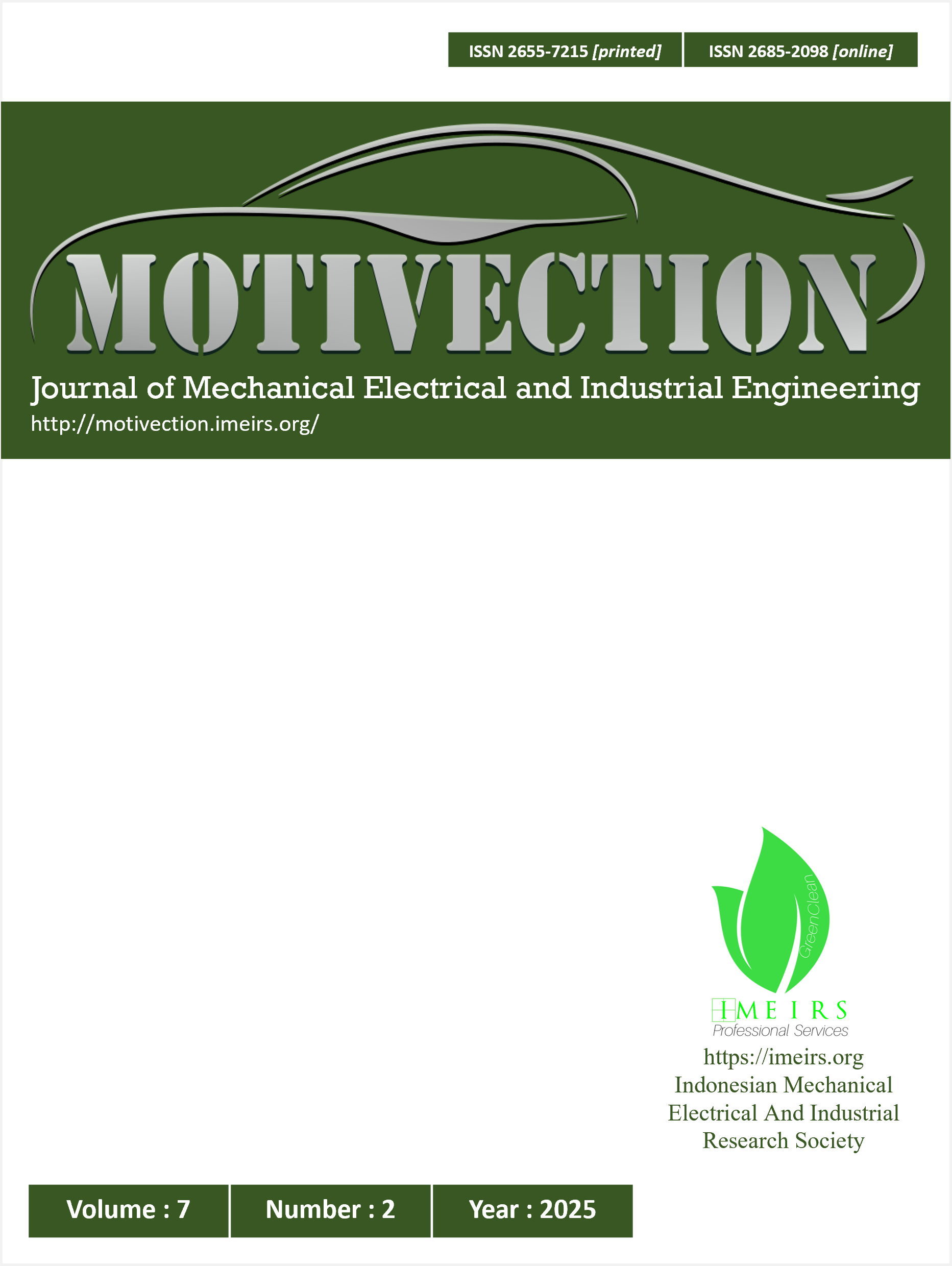Monitoring Of Household Electricity Usage Based On The Internet Of Things
##plugins.themes.academic_pro.article.main##
Abstract
The increasing demand for energy efficiency in the digital era has accelerated the adoption of Internet of Things (IoT)-based technologies in household electricity management. This study presents the design and implementation of an IoT-based real-time electricity monitoring system using the ESP32 microcontroller and PZEM-004T sensor, integrated with the Blynk application for remote access. The system measures voltage, current, power, energy consumption, and cost, displaying data on both an LCD and a mobile interface. Experimental testing involved household appliances such as fans and rice cookers under individual and combined usage, with measurements taken at 15-minute intervals. The results demonstrated strong agreement between theoretical calculations and real-time data, with the measured values slightly higher due to the dynamic nature of electrical loads. The system achieved a low average error rate of 0.17%, with a maximum error of 0.30%. These findings confirm the accuracy and reliability of the system, supporting its potential for enhancing user awareness, improving billing precision, and contributing to sustainable energy use in smart home applications.
##plugins.themes.academic_pro.article.details##

This work is licensed under a Creative Commons Attribution 4.0 International License.
Copyright (c): Muhammad Hanif Fatin, Nasron Nasron, Sarjana Sarjana, Muhammad Renaldy Saputra (2025)References
[2] L. Halim, A. Putra, and D. Wicaksono, “Non‑intrusive load monitoring: A cost‑effective approach for home appliance identification using PZEM‑004T and Wemos D1,” *Eastern-European Journal of Enterprise Technologies*, vol. 1, no. 8, pp. 62–70, Jan. 2025. https://doi.org/10.15587/1729-4061.2025.316694
[3] M. W. Isa and X. Chang, “IoT‑Based non‑intrusive energy wastage monitoring in modern building units,” in *Wireless Algorithms, Systems, and Applications*, Springer, 2021, pp. 161–173. https://doi.org/10.1007/978-3-030-85928-2_14
[4] Y. Liu, J. Chen, and K. Zhang, “Non‑Intrusive Load Monitoring based on unsupervised optimization enhanced neural network deep learning,” *Frontiers in Energy Research*, vol. 9, Art. no. 718916, Aug. 2021. https://doi.org/10.3389/fenrg.2021.718916
[5] L. Tightiz and H. Yang, “A comprehensive review on IoT protocols’ features in smart grid communication,” *Energies*, vol. 13, no. 11, Art. no. 2762, Jun. 2020. https://doi.org/10.3390/en13112762
[6] D. A. Ratnasari, B. Suprianto, and F. Baskoro, “Monitoring Daya Listrik pada Panel Surya Berbasis IoT Menggunakan Aplikasi Telegram,” Indonesian Journal of Electrical Engineering, vol. 10, no. 3, 2020. https://doi.org/10.26740/inajet.v5n1.p1-10
[7] IS. Hudan and T. Rijanto, “Rancang Bangun Sistem Monitoring Daya Listrik pada Kamar Kos Berbasis IoT,” Jurnal Teknik Elektro, 2019. https://doi.org/10.26740/jte.v8n1.p%25p
[8] SI. Haryudo, RD. Alfian, and N. Kholis, “Rancang Bangun Alat Monitoring Pemakaian Tarif dan Kontrol Daya Listrik pada Rumah Kos Berbasis IoT,” 2019. https://doi.org/10.26740/jte.v10n3.p661-670
[9] J. Lianda, D. Handarly, and A. Adam, “Sistem Monitoring Konsumsi Daya Listrik Jarak Jauh Berbasis IoT,” JTERA, vol. 4, no. 1, 2019. http://dx.doi.org/10.31544/jtera.v4.i1.2019.79-84
[10] AA. Pradana, P. Yuliantoro, and S. Indriyanto, “Perancangan Sistem Monitoring Daya Listrik 1 Fasa pada Rumah Tangga Berbasis IoT,” Jurnal SINTA, 2024. https://doi.org/10.61124/sinta.v1i1.13
[11] Z. Zakwansyah, F. Fitriady, and M. A. Haikal, “Monitoring Pemakaian Daya Listrik Rumah Berbasis IoT,” Jurnal JEETech, vol. 2, no. 1, 2024. https://doi.org/10.32492/jeetech.v5i1.5109
[12] D. Wijanarko, “Sistem Monitoring Daya Listrik Berbasis IoT Menggunakan API,” Jurnal Teknologi Informasi, 2024. https://doi.org/10.25047/jtit.v10i2.337
[13] F. Pandansari, H. Prasetyo, and Y. T. Tularsih, “Analisa Pengembangan Sistem Pemantau Daya Listrik Berbasis IoT,” Jurnal Teknik, 2021. https://doi.org/10.37031/jt.v19i2.185
[14] S. Nor, “Penerapan IoT sebagai Pengendali Peralatan Listrik dan Pemantau Daya Listrik Berbasis Web,” EEICT Conference, 2019. http://dx.doi.org/10.31602/eeict.v2i2.4431
[15] D. Azizi and V. Arinal, “Sistem Monitoring Daya Listrik Menggunakan IoT Berbasis Mobile,” JIMIK, vol. 6, no. 2, 2020. https://doi.org/10.35870/jimik.v4i3.409
[16] D. H. Manik, R. Nandika, and P. Gunoto, “Penerapan IoT pada Sistem Monitoring Pemakaian Daya Listrik Rumah Tangga,” 2020. https://doi.org/10.37253/telcomatics.v4i2.613
[17] IF. Pamungkas, UT. Kartini, T. Wrahatnolo, and J. Joko, “Sistem Monitoring Daya Listrik Photovoltaic Berbasis IoT,” Jurnal Teknik Elektro, 2020. https://doi.org/10.26740/jte.v11n2.p236-245
[18] I. G. B. Adi Pramana, L. A. S. I. Akbar, and C. Ramadhani, “Development of an IoT-Based Smart Home Prototype Using the Blynk Application”, MOTIVECTION, vol. 7, no. 1, pp. 25-36, Feb. 2025. https://doi.org/10.46574/motivection.v7i1.424
[19] L. Sabila, L. Dwiyono, A. Hakim, A. Karuana, and D. Hakika, “IoT-Based Monitoring System for Temperature and pH Control in Cocoa Fermentation”, MOTIVECTION, vol. 7, no. 1, pp. 1-12, Feb. 2025. https://doi.org/10.46574/motivection.v7i1.381
[20] G. Sihombing and M. W. Pratama, “Analisis Pengaruh Fluktuasi Sumber Daya Listrik Terhadap Keakuratan Pengukuran Daya,” Jurnal MAJEMUK, vol. 6, no. 2, pp. 45–52, 2025. https://doi.org/10.55338/jumin.v6i3.6145
[21] U. Achlison, R. T. Handoko, and Y. D. Pangestu, “Analisis Hasil Ukur Sensor Arus dan Tegangan untuk Memantau Daya Listrik berbasis Microcontroller,” Jurnal ELKOM, vol. 11, no.1, pp. 15–22, 2023. https://doi.org/10.51903/elkom.v16i1.1193
[22] A. Tama, I. S. Wibawa, and D. W. Sari, “Analisis Pengaruh Perubahan Arus Eksitasi Terhadap Tegangan Keluaran dan Daya Reaktif di PLTG Gilimanuk,” Jurnal Ilmiah Teknik, vol. 9, no. 2, pp. 58–66, 2024. https://doi.org/10.32493/epic.v7i1.38427

